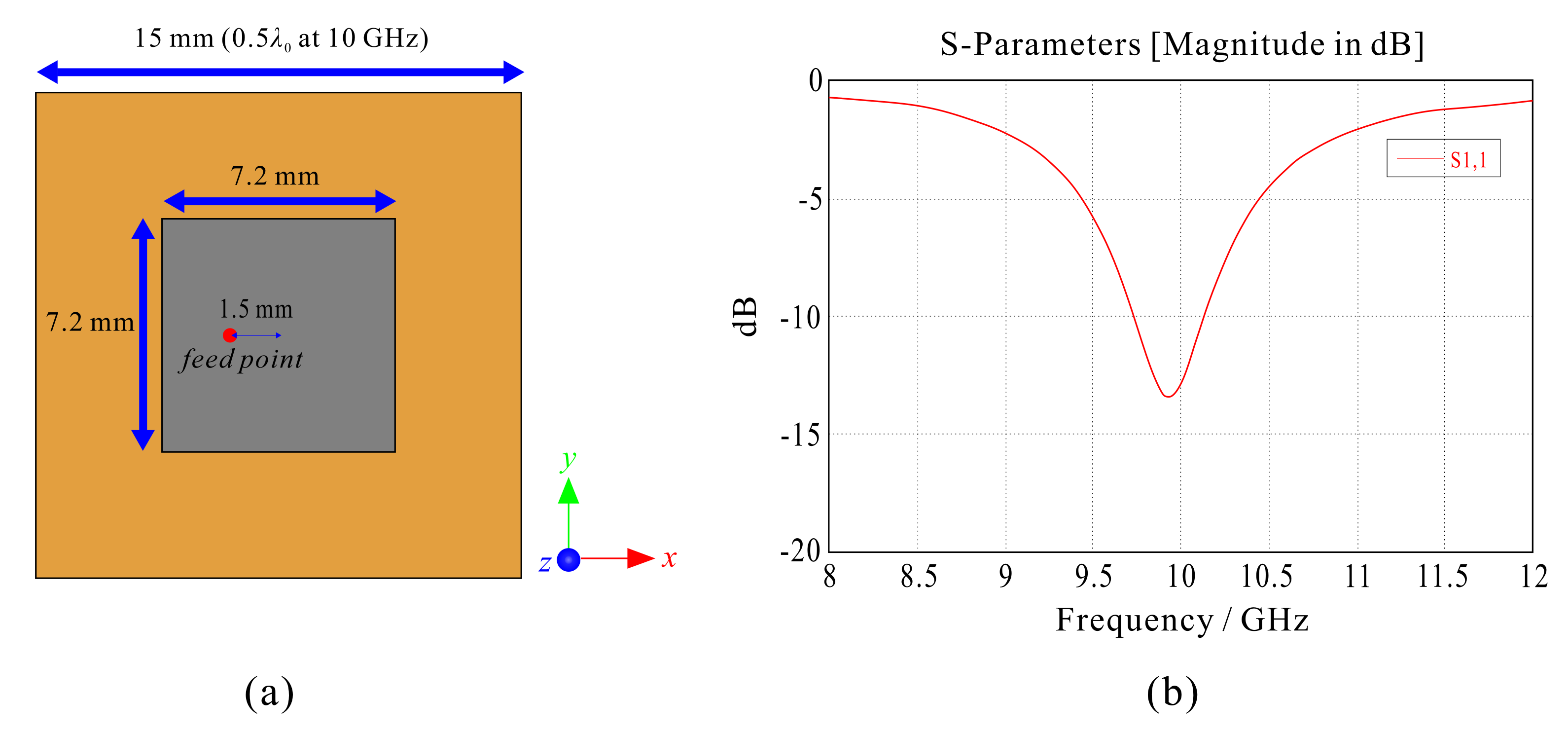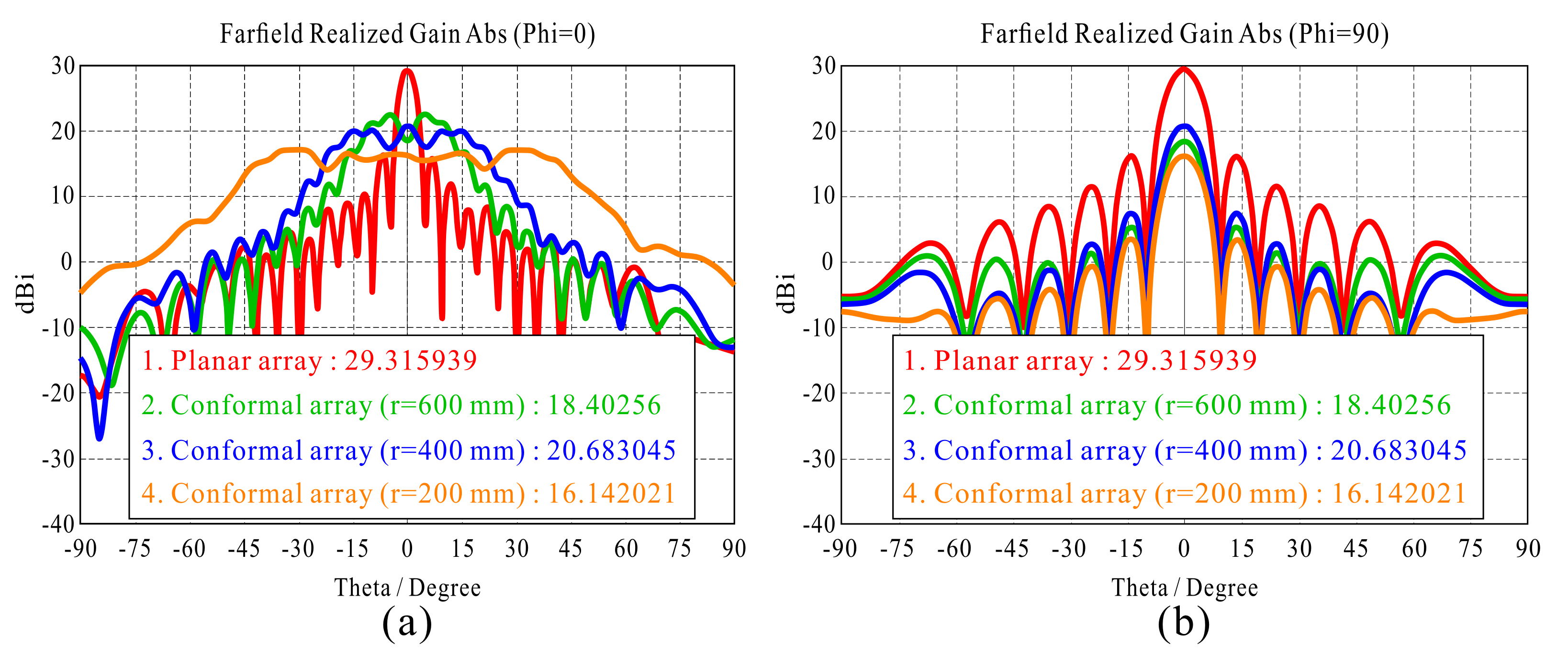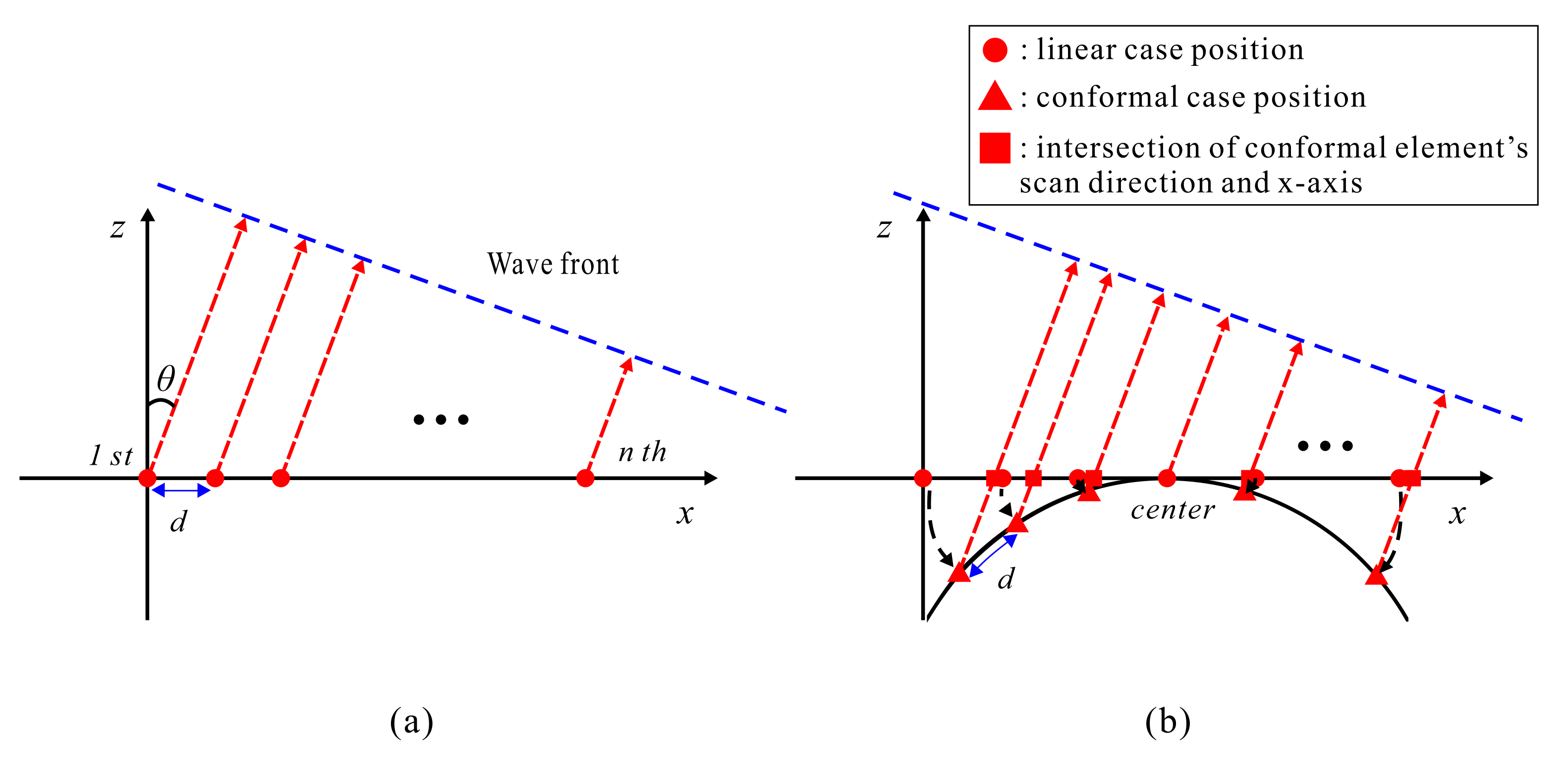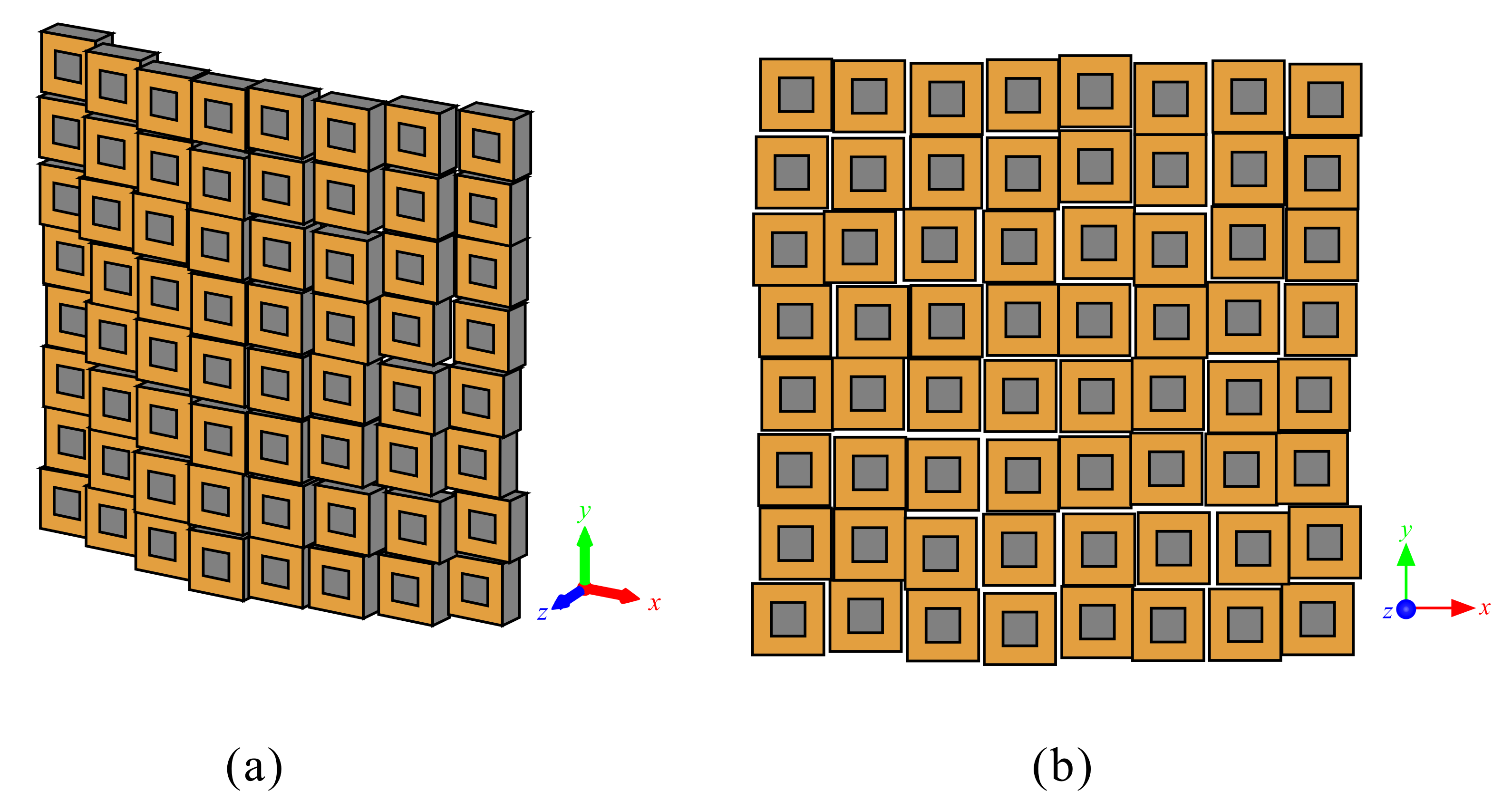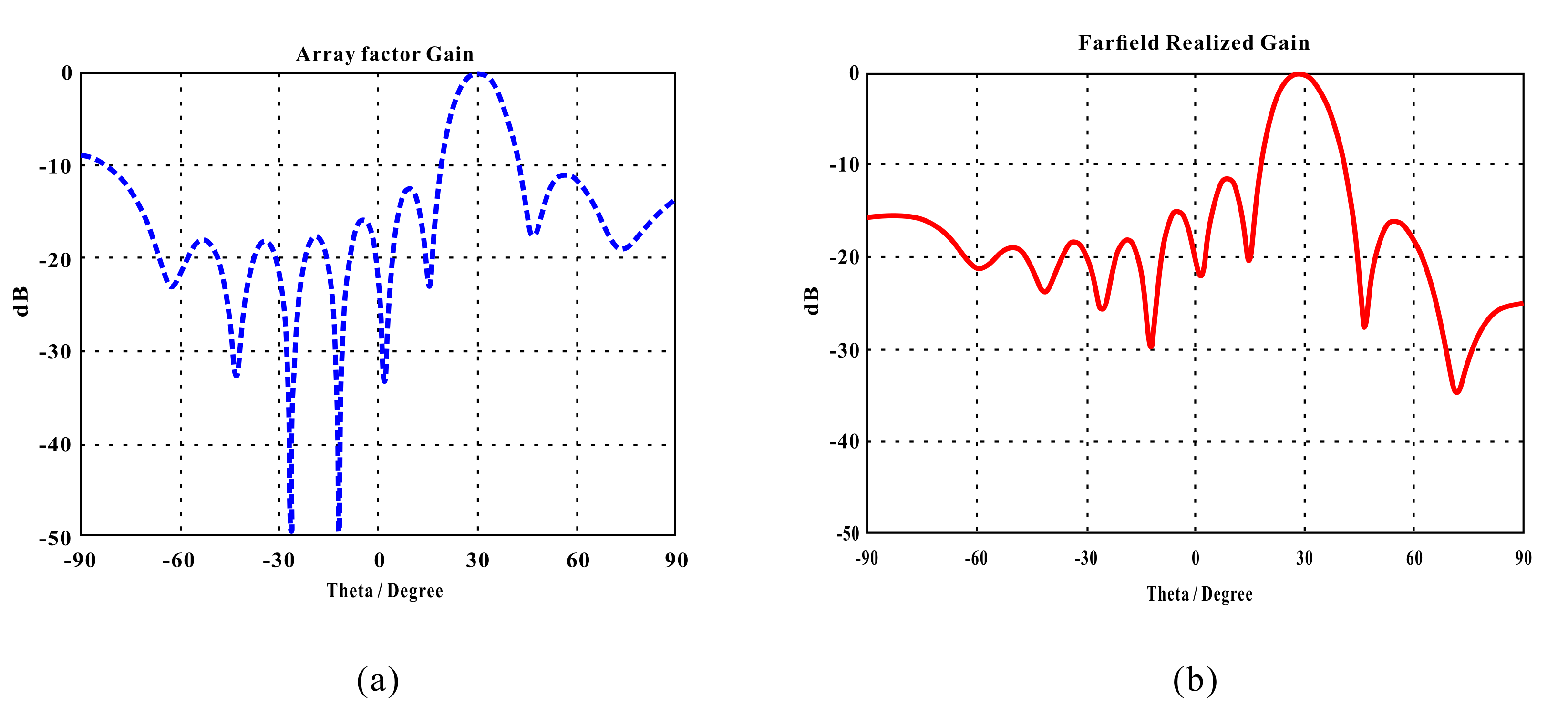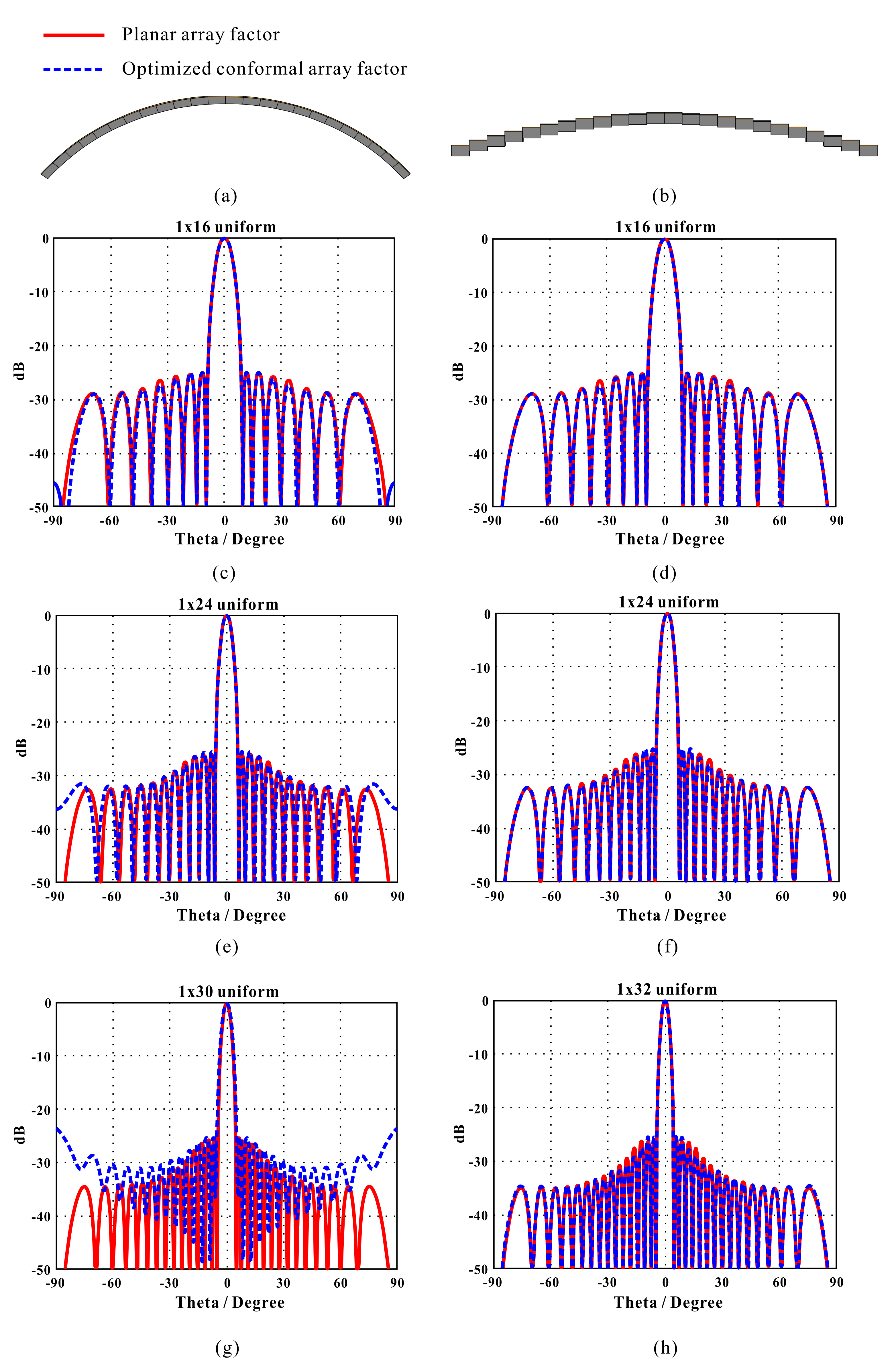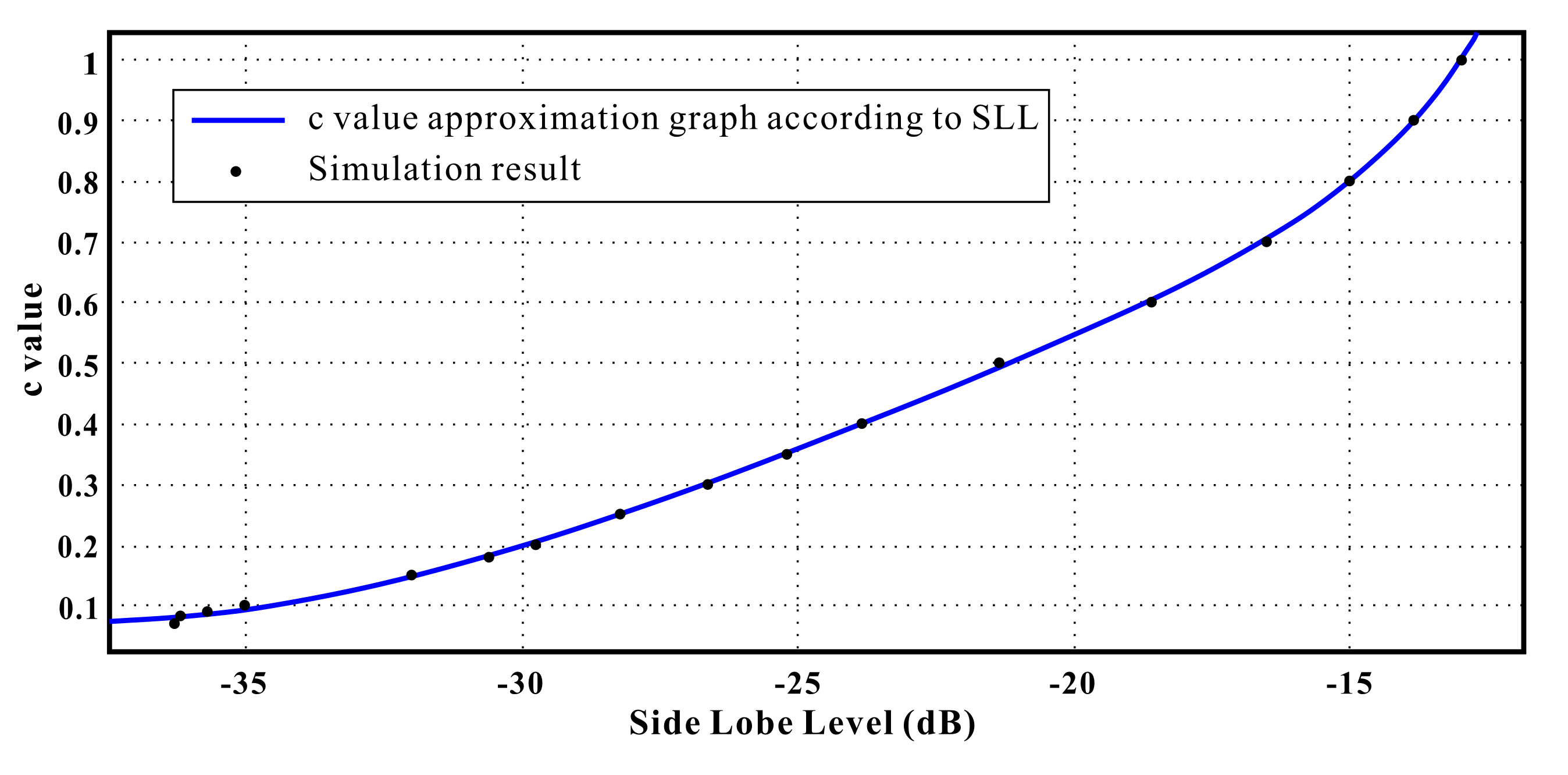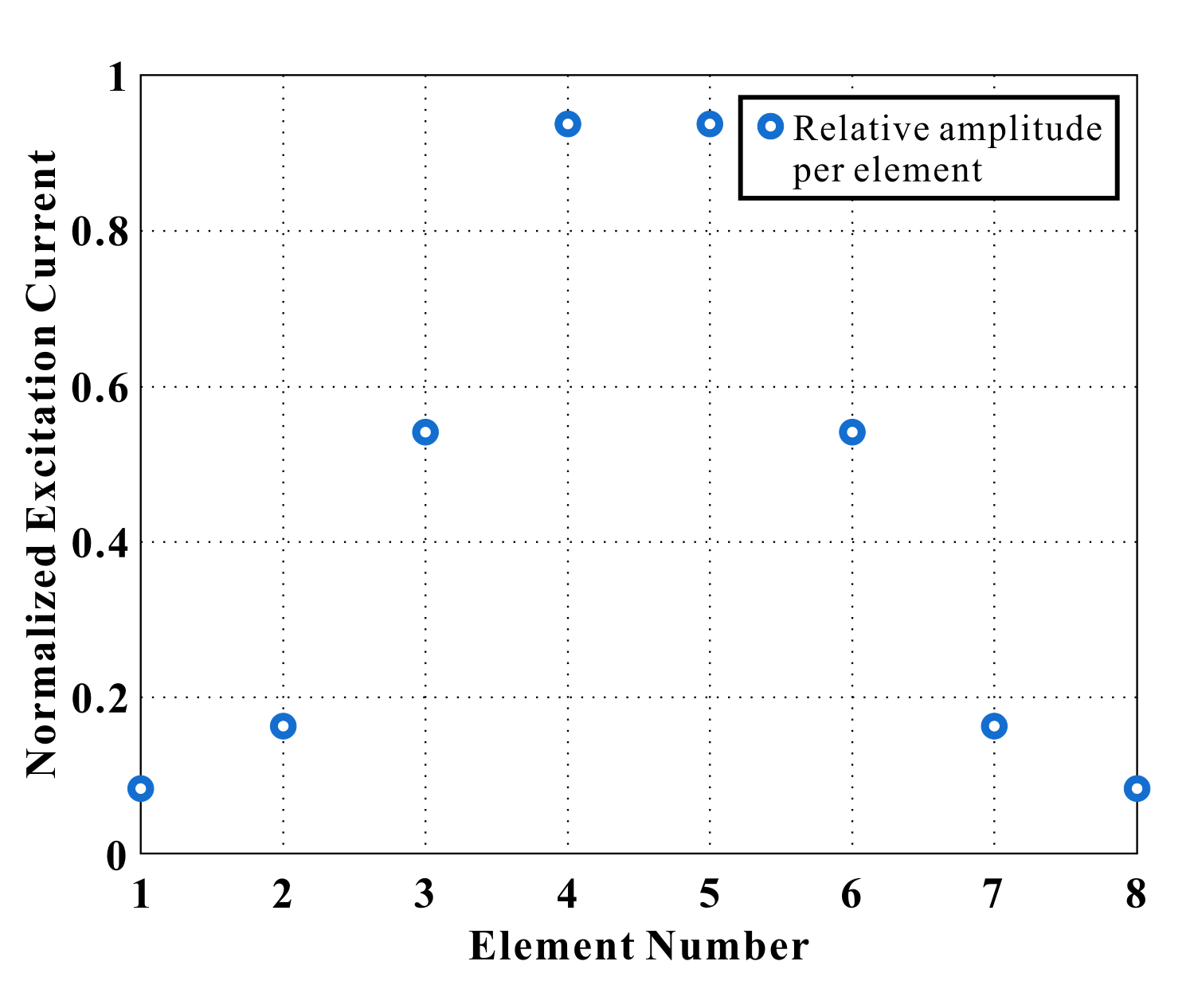2.1. Improvement of Pattern Degradation of Conformal Arrays through Phase Compensation
To investigate the change in electrical characteristics according to the platform shape of the conformal arrays, we designed a patch antenna operating at 10 GHz (
Figure 1). Taconic’s RF-35 (dielectric constant = 3.5) was used as a substrate for the patch antenna with a thickness of 1.52 mm. Coaxial feeding was employed, and the broadside gain of a single radiation element was about 6.2 dB. In the patch antenna, the radiating element has the size of x-direction element spacing, dx = 0.5
, and y-direction element spacing, dy = 0.5
(15 mm). We compared the pattern performance of a 12
24 planar array using the designed patch antenna as a single radiation element and the radiation pattern of a 12
24 conformal array.
The conformal array is cylindrical, and the variable
r is the radius of the cylindrical array platform, as shown in
Figure 2. When
r for the 12
24 planar and the conformal arrays is
r = 200, 400, and 600 mm, the 2D radiation patterns under uniform amplitude and in-phase feeding are as shown in
Figure 3.
The pattern of the conformal array significantly differs from that of the planar array according to the change in the platform (change in r) even with the same radiating element shape, number of radiating elements, and radiating element spacing. In the presented case, as r becomes shorter (as the curvature increases), the element location situation changes, and it can be seen that the gain is decreased and the beam is widely distributed due to the phase difference up to the same-phase wave front. The cause of performance degradation in uniform feeding was analyzed from a phase perspective by schematically illustrating a cylindrical situation bent along the x-axis.
Figure 4a shows the position of each radiation element in a planar array condition. Unlike the planar array (
Figure 4a), the z-axis coordinates for the conformal array changes for each radiation element as the element position changes over the curve (
Figure 4b). To obtain the phase length to the wavefront in
Figure 4b, the array factor of the conformal array can be calculated by considering the z-axis coordinates or the phase compensation for the phase delay, which is the distance from the actual element position to the x-axis. In other words, for uniform amplitude feeding, conformal arrays require the modification of the array factor (Equation (
1)) used for planar arrays.
When the positions of the elements in
Figure 4a correspond to the XZ plane, as shown in
Figure 4b, it can be represented as shown in
Figure 5. The element coordinate of the planar array
is moved to that in the form of a conformal array. To calculate the phase on the x-axis, we consider the phase difference as much as
, which is the length between the corresponding positions
and
on the x-axis. If Equation (
1) is solved considering the phase difference of
for the conformal array, the array factor in
Figure 4b can be obtained. The phase difference
can be expressed as follows.
Assuming that the interval between elements of conformal arrays is 0.5
,
,
is expressed as follows:
This is based on the corresponding coordinates
considering the phase difference, which is substituted into Equation (
1) and calculated as follows:
Substituting
into Equation (
5) and rearranging
z, we obtain Equation (
6).
As expressed in Equation (
6), the array factor considering
in the uniform amplitude feeding example for cylindrical conformal arrays is converted into a universal coordinate equation including the z-coordinate. In a case where y-axis coordinates do not exist, the variable for
is excluded because the value of
cannot be adjusted. For 3D expansion, we consider the y-axis coordinates and
in the array factor. Since the coordinates on the z-axis do not change with a change in
, it maintains the form (
z), which changes only under the change of
. The xy plane changes to a shape displayed on the UV plane (
x,
y).
If this is expanded with respect to point
on the 3D coordinate axis of the elements constituting an arbitrary array shape including the y-axis coordinate,
is expressed as follows:
We propose an equation that can calculate the phase regardless of the grid format, curvature, and nonlinearity if the positions of all possible elements that can be specified on the 3D coordinate axis are located through the array factor for uniform amplitude feeding in Equation (
8).
2.2. Results of Array Factor Calculation through Simulations
We verified the 3D array factor by simulating a situation of uniform amplitude feeding based on the proposed equation for the 3D array factor. In the form of a single element, we designed a cavity-backed patch antenna operating at 10 GHz.
The designed cavity-backed patch antenna is shown in
Figure 6a. RF-35 (dielectric constant = 3.5) from Taconic with a thickness of 0.51 mm was used as a substrate for the antenna. The substrate is 15 mm on the x-axis and 15 mm on the y-axis. The cavity is set to metal with a total length of 7 mm in the z-direction. The cavity is 1.5 mm thickness in the x- and y-direction and 2 mm thickness in the z-direction. The inside of the metal is set to air. Coupling feeding was employed [
18,
19,
20]. The cavity-backed patch antenna (
Figure 6a) has a patch size of 7 mm on the x-axis and 7 mm on the y-axis, and the thickness of the cavity layer is 7 mm. The bandwidth of reflection coefficient below −10 dB is 9.242–10.81 GHz, as shown in
Figure 6b. The element pattern for the cavity-backed patch antenna is shown in
Figure 6c. The broadside gain of the single radiation element is approximately 5.479 dBi.
Figure 7 shows the shape of an 8
8 random grid array using the cavity-backed patch antenna as a single radiation element. The element spacing was calculated as the distance between patch centers. The element spacing in the x- and y-directions, dx and dy, respectively, were randomly set to 0.5
–0.56
(15–16.8 mm), and that in the z-direction dz was set to 0–0.2
(0–6 mm). The calculated array factor scanned at
= 0
,
= 30
under uniform amplitude feeding was compared with the radiation pattern obtained from EM simulations.
Figure 8 shows the array factor and radiation pattern at 10 GHz when the shape of the conformal array is as shown in
Figure 7.
Figure 8a shows the 3D array factor calculated using MATLAB, and
Figure 8b shows the radiation pattern of the conformal array simulated by substituting the phase obtained from Equation (
11). The patterns shown in
Figure 8a,b are very similar. However,
Figure 8a shows only the calculated array factor, and
Figure 8b show the array factor in
Figure 8a and the element pattern in
Figure 6c, so that the reduction is reflected in the gain of
= −90
and
= 90
.
These confirm that performance prediction and control in the case of 3D and random arrangement can be achieved using the proposed 3D array factor for uniform amplitude feeding (Equation (
11)) by calculating an array factor for an arbitrary array and adjusting the element pattern to adjust the array pattern.
2.3. Amplitude Tapering Method of Array Factor (Bernstein Polynomial Using GLPSO)
We confirmed in the preceding subsections that a phase can be calculated for arbitrary arrays that can specify the element position in the 3D coordinate system using the 3D array factor in cases of the uniform amplitude feeding. However, as with planar arrays, it is necessary to adjust the amplitude for the desired side-lobe level (SLL) in conformal arrays. Thus, Equation (
10) considering the amplitude
of the
ith element with respect to the previously proposed
expresses the array factor for the final 3D array.
However, as with a phase, the conformal array cannot achieve the desired performance using only the amplitude method for planar arrays due to the structural differences and nonlinearity. Consequently, several amplitude tapering methods have been studied for applications in conformal arrays. Conformal-array amplitude tapering has been performed using the Particle Swarm Optimization (PSO) method on Bernstein polynomials based on the structure for conformal array situations, and only amplitude was optimized to increase radiation efficiency and lower SLL [
2]. However, it can be used universally because phase-related parts are excluded. It can also be used for a particular case. Herein, based on phase compensation, we employed GLPSO, which is more advanced than PSO, GLSPO combines Genetic Algorithm (GA) and PSO, and whenever an iteration is performed, the entire cluster moves in the optimization direction and causes specific objects to mutate and converge to the global optimum at a high speed [
17]. The GLPSO setting was performed using 2000 particles, probability of mutation = 1%, probability of tournament = 20%, and the maximum number of repetitions of 1000. By analyzing the optimized data, the trend of the variable was observed. We propose the generalizability of amplitude tapering of conformal arrays by analyzing the trend of the optimization results. The Bernstein polynomial used for optimization is expressed as follows. In this case, the objective is to optimize the Bernstein polynomial variables
,
,
, and
.
A is set to 0.5 because the shape of the arrangement is symmetric, and beam steering is not performed.
For optimization, the element positions of 1
16, 1
24, 1
30, and 1
32 conformal arrays were used. All arrays had an x-direction element spacing of dx = 0.5
(15 mm) at 10 GHz, and the z-direction element spacing dz was randomly set. The array factors were calculated using MATLAB for the given arrays and compared with the −25 dB Taylor array factor using the Taylor distribution for the planar arrays. The cost function used to optimize the array factor is the same as Equation (
13).
The optimization cost function was set as follows, because the SLL values of the first and second SSLs are very close to the SLL value of the desired level, and other SLLs were set to naturally have SLLs within a certain value.
Figure 9 shows a plot of the array factors with respect to the optimized Bernstein polynomial variable. In the array factor graph, it can be seen that the array factor of a linear array with the same number of elements is similar to that of a conformal array. Analyzing the output data after verifying the performance of GLPSO and validity of the cost function, we confirmed that
and
correspond to a certain curvature, and the number of elements is fixed. When c changes, it has a specific inflection point and can be expressed generally for a value of c above a specific inflection point.
Figure 10 shows the changes in
and
when dx = 0.5
(15 mm), dz is randomly set to a 1
16 conformal array at 10 GHz, and
=
= 5. (Since it is a symmetric structure, we assume that
=
=
c.)
By arranging the experimentally obtained data in
Figure 10, we find that the case of a 1
16 conformal array can be approximated as a function of
c-value according to SLL (
Figure 11). We obtain an expression by analyzing the trend of the optimization results that fit the array case. Based on this, for a specific conformal array, the relation between
c and SLL can be obtained based on
and
, which are obtained through optimization.
Figure 12a shows the actual shape of the 1
16 conformal array used for the CST simulation based on the information used for the MATLAB optimization.
Figure 12b compares the radiation pattern of the conformal array without beam scanning and the planar-array radiation pattern to observe only the amplitude effect. The red solid line indicates dx = 0.5
(15 mm) for the 1
16 planar array at 10 GHz and the radiation pattern when −25 dB Taylor distribution is applied. The blue dash line indicates dx = 0.5
(15 mm) at 10 GHz, and dz represents the randomly set 1
16 conformal array radiation pattern. Variables of the Bernstein polynomial applied to the 1
16 conformal array were set to
=
= 5,
=
= 0.3 according to the expressions obtained above, and
Figure 11 shows that the first SLL is −26.5 dB. Simulation results show that the first SLL is −26.57 dB in the case of conformal arrays (
Figure 12b), which is comparable to −26.5 dB. In addition, the radiation pattern of the 1
16 planar array shows a decreasing trend with similar values, not only the shape of the pattern and the first SLL, but all SLL values.
Figure 11 and the simulated radiation patterns (
Figure 12b) confirm that it is possible to derive a conformal-array amplitude tapering relationship that can be universally used depending on the situation through optimization results and variable control.
